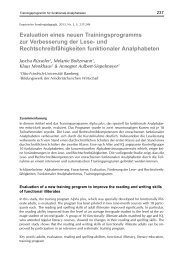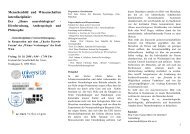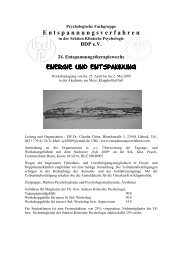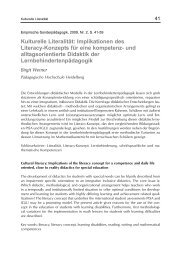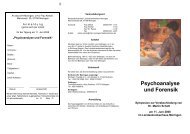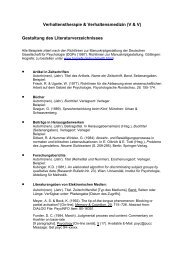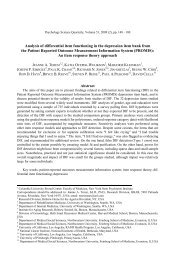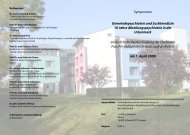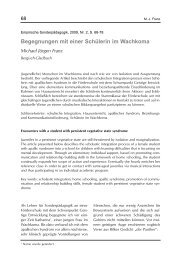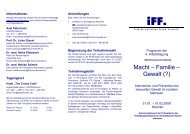Scale construction and evaluation in practice: A review of factor ...
Scale construction and evaluation in practice: A review of factor ...
Scale construction and evaluation in practice: A review of factor ...
Create successful ePaper yourself
Turn your PDF publications into a flip-book with our unique Google optimized e-Paper software.
<strong>Scale</strong> <strong>construction</strong> <strong>and</strong> <strong>evaluation</strong> <strong>in</strong> <strong>practice</strong> 281<br />
Sample sizes tend to be somewhat larger for <strong>evaluation</strong> studies than for other types <strong>of</strong><br />
studies. This could be due to the fact that an <strong>evaluation</strong> study is <strong>of</strong>ten performed as a<br />
secondary analysis <strong>of</strong> data collected <strong>in</strong> a large study to <strong>in</strong>vestigate properties <strong>of</strong> the latent<br />
variable the scale is supposed to measure. But aga<strong>in</strong>, given the large variation <strong>in</strong> sample<br />
size <strong>and</strong> the limited number <strong>of</strong> studies, it is not clear how general the observed pattern is.<br />
Statistical analyses reported<br />
Descriptive statistics<br />
Item means are reported <strong>in</strong> five <strong>of</strong> the 32 FA studies, <strong>in</strong> one <strong>of</strong> the three studies where<br />
both FA <strong>and</strong> IRT are applied, <strong>and</strong> <strong>in</strong> four <strong>of</strong> the six IRT studies. In a fifth IRT study,<br />
item difficulty parameters are reported. This difference between FA <strong>and</strong> IRT applications<br />
is to be expected, s<strong>in</strong>ce one <strong>of</strong> the focal po<strong>in</strong>ts <strong>of</strong> IRT is assessment <strong>of</strong> item difficulty, <strong>of</strong><br />
which the item mean is an <strong>in</strong>dicator. In contrast, when the l<strong>in</strong>ear <strong>factor</strong> model is applied,<br />
observed variables are <strong>of</strong>ten implicitly assumed to be measured as deviations from their<br />
means, except when multiple groups are compared (cf. Brown, 2006, p. 54). In addition,<br />
researchers apply<strong>in</strong>g IRT are traditionally more <strong>in</strong>terested <strong>in</strong> item characteristics,<br />
whereas researchers who favor FA are more focused on the multidimensional structure<br />
<strong>of</strong> the data (cf. Harman, 1968).<br />
In 38 <strong>of</strong> the studies (93 %), parameters are estimated. The other three studies are nonparametric<br />
IRT applications. When report<strong>in</strong>g parameter estimates, it is recommended to<br />
also report correspond<strong>in</strong>g st<strong>and</strong>ard error estimates, because they conta<strong>in</strong> <strong>in</strong>formation<br />
about the variability, hence the reliability <strong>of</strong> the parameter estimates (e.g., Boomsma,<br />
2000; McDonald & Ho, 2002). This is especially important for studies with small sample<br />
sizes or small respondent/item ratios, where st<strong>and</strong>ard errors can be relatively large. Nevertheless,<br />
st<strong>and</strong>ard errors are only provided <strong>in</strong> four <strong>of</strong> the 38 studies.<br />
In 27 <strong>of</strong> the studies (66 %), some <strong>in</strong>formation is given about the distribution <strong>of</strong> the estimated<br />
latent variable scores <strong>in</strong> the sample. In 13 <strong>of</strong> these, <strong>in</strong>formation about unweighted<br />
sum scores is reported; <strong>in</strong> one study (Hong & Wong, 2005), latent trait estimate <strong>in</strong>formation<br />
is provided; <strong>and</strong> <strong>in</strong> two studies, the average item scores are given. In 11 <strong>of</strong> these<br />
studies, it is unclear what k<strong>in</strong>d <strong>of</strong> latent variable estimate is employed. Information about<br />
the distribution usually consists <strong>of</strong> means <strong>and</strong> st<strong>and</strong>ard deviations (20 studies), but additional<br />
distributional properties (e.g., skewness <strong>and</strong> kurtosis) are also discussed <strong>in</strong> six<br />
studies. In one study (Glutt<strong>in</strong>g, Watk<strong>in</strong>s, & Youngstrom, 2005), only the mean is provided.<br />
Correlations between the latent variable estimates are reported <strong>in</strong> 29 <strong>of</strong> the 34 multidimensional<br />
studies.



